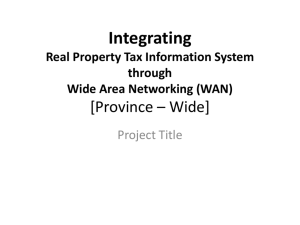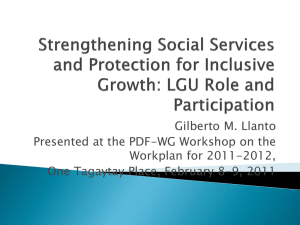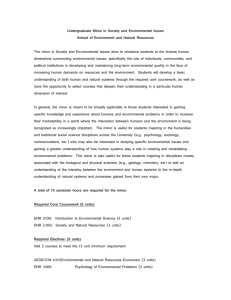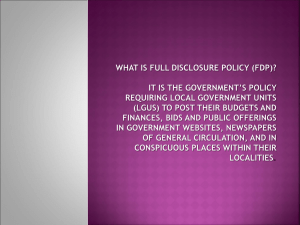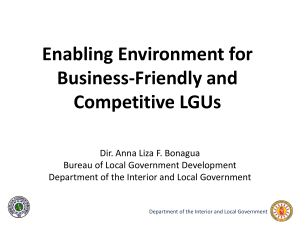PB 12-01 ENR - June 28_final_revised.pmd
advertisement
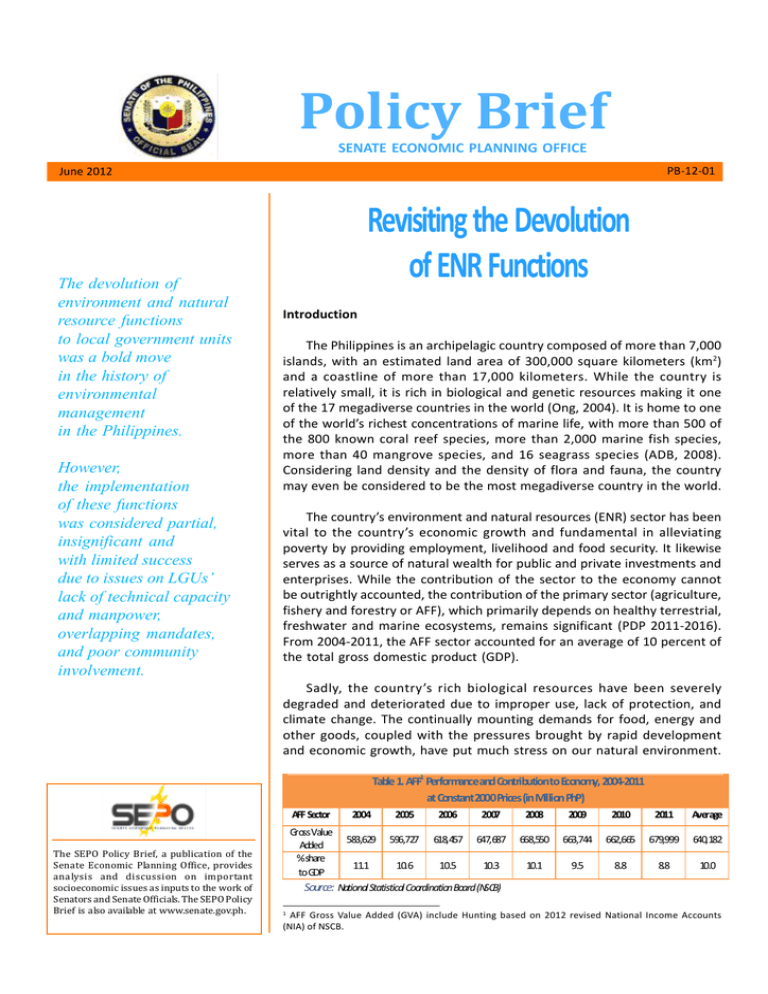
Policy Brief SENATE ECONOMIC PLANNING OFFICE PB-12-01 June 2012 The devolution of environment and natural resource functions to local government units was a bold move in the history of environmental management in the Philippines. However, the implementation of these functions was considered partial, insignificant and with limited success due to issues on LGUs’ lack of technical capacity and manpower, overlapping mandates, and poor community involvement. Revisiting the Devolution of ENR Functions Introduction The Philippines is an archipelagic country composed of more than 7,000 islands, with an estimated land area of 300,000 square kilometers (km2) and a coastline of more than 17,000 kilometers. While the country is relatively small, it is rich in biological and genetic resources making it one of the 17 megadiverse countries in the world (Ong, 2004). It is home to one of the world’s richest concentrations of marine life, with more than 500 of the 800 known coral reef species, more than 2,000 marine fish species, more than 40 mangrove species, and 16 seagrass species (ADB, 2008). Considering land density and the density of flora and fauna, the country may even be considered to be the most megadiverse country in the world. The country’s environment and natural resources (ENR) sector has been vital to the country’s economic growth and fundamental in alleviating poverty by providing employment, livelihood and food security. It likewise serves as a source of natural wealth for public and private investments and enterprises. While the contribution of the sector to the economy cannot be outrightly accounted, the contribution of the primary sector (agriculture, fishery and forestry or AFF), which primarily depends on healthy terrestrial, freshwater and marine ecosystems, remains significant (PDP 2011-2016). From 2004-2011, the AFF sector accounted for an average of 10 percent of the total gross domestic product (GDP). Sadly, the country’s rich biological resources have been severely degraded and deteriorated due to improper use, lack of protection, and climate change. The continually mounting demands for food, energy and other goods, coupled with the pressures brought by rapid development and economic growth, have put much stress on our natural environment. Table 1. AFF1 Performanceand Contributionto Economy, 2004-2011 at Constant2000Prices (in Million PhP) AFF Sector The SEPO Policy Brief, a publication of the Senate Economic Planning Office, provides analysis and discussion on important socioeconomic issues as inputs to the work of Senators and Senate Officials. The SEPO Policy Brief is also available at www.senate.gov.ph. GrossValue Added %share to GDP 2004 2005 2006 2007 2008 2009 2010 2011 Average 583,629 596,727 618,457 647,687 668,550 663,744 662,665 679,999 640,182 11.1 10.6 10.5 10.3 10.1 9.5 8.8 8.8 10.0 Source: National Statistical Coordination Board (NSCB) 1 AFF Gross Value Added (GVA) include Hunting based on 2012 revised National Income Accounts (NIA) of NSCB. 1 These have resulted in the subversion of ecosystems, destruction of natural habitats, and an alarming rate of biodiversity loss. Cognizant of this predicament and the relative importance of the ENR sector, various ENR policies and legislations have been crafted by the government. One of the breakthroughs in the history of environmental management is the devolution of ENR functions to local government units (LGUs) as provided by Republic Act No. 7160 or the Local Government Code (LGC) of 1991. The LGC grants the country’s territorial and political subdivisions the principal responsibility of ENR management. But while some LGUs have been successfully implementing devolved ENR functions, a number of studies have appraised that the devolution of ENR functions in the country was partial, insignificant and with limited success. The purpose of this paper is to identify devolution challenges in the ENR sector, and propose mechanisms and strategies that Congress may consider in its policy formulation. administrative capacity of subnational units, relieve top officials of routine tasks, improve coordination, integrate isolated or lagging areas into wider economies of scale, and improve efficiency. In a 2007 study conducted by the League of Municipalities of the Philippines (LMP), three major reasons were indentified why the country’s ENR functions should be devolved. First, it is mandated by the law. Second, it is an administrative necessity to improve the delivery of environmental services nationwide. Third, it is a politically and environmentally correct thing to do. a) It is mandated by the law. Section 17 of the LGC stipulates that every LGU shares responsibility in the sustainable management and development of the environment and natural resources within their jurisdiction. As such, they shall endeavor to be selfreliant and shall continue to exercise the powers and discharge the duties and functions devolved to them. Background of ENR Devolution in the Philippines Devolution2 in the country formally started with the enactment of the LGC in 1991, which gave life to decentralization and local autonomy as enshrined in the Philippine Constitution. It envisions the dispersal of powers, authority and responsibility from the national government to subnational structures (local governments). It emanated on the principle that effective local governance coupled with people’s participation results in the empowerment of people and the improvement of their quality of life. One of the major services devolved to LGUs is environmental management. Like other basic services such as agriculture, health, public works and social welfare, ENR management was devolved to the LGUs because of their essential role in the management and protection of natural resources. LGUs are directed to integrate environmental aspects in local development planning and implement environmental protection programs and projects as well as enforce laws and regulations. According to Rondinelli and Cheema (1983), the dispersal of powers and functions to LGUs is a means to overcome limitations of central planning, cut the red tape, increase information on local needs, develop the 2 Devolution as defined by the LGC is a system of granting territorial and political subdivisions with genuine and meaningful local autonomy to enable the LGUs to attain their fullest development as self-reliant communities and make them more effective partners in the attainment of national goals. Toward this end, the State shall provide for a more responsive and accountable local government wherein LGUs shall be given more powers, authority, responsibilities, and resources. 2 b) It is an administrative necessity to improve the delivery of environmental services nationwide. Local environmental management is one major area where LGUs demonstrated innovations and brilliance in local governance. The passage of the LGC made LGUs strong deliverers of services and successfully initiated the protection and sustainable use of environmental assets and natural resources. Bearing this out are the outstanding Galing Pook3 Awardees for ENR Sector from 2007-2010 (Table 2). The awards demonstrated the LGUs’ innovation and excellence in environmental management. While no LGU made to the list of outstanding Galing Pook Awardees in 2011 under the ENR Category, two LGUs were included among the finalists, namely: Tagum City for the Watershed, River Management, Livelihood and Disaster Risk Reduction Program; and Batangas City for Solid Waste Management Enterprise through LGU-Cooperative Partnership. c) It is a politically and environmentally correct thing to do. The Philippines is an archipelago of highly diverse cultures, traditions, belief systems, political histories, environmental conditions, and arrays of natural resources. They are so diverse that no one agency of the national government can attend to all their different forms and presentations. LGUs are deemed in the best position to act as frontrunners 3 The Galing Pook Award was launched on October 21, 1993 as a pioneering program that searches and recognizes innovative practices by LGUs. LGU finalists with outstanding initiatives are carefully selected and winners are recognized in a very prestigious awards ceremony. The award is conferred by the President of the Republic of the Philippines. Table 2. Gawad Galing Pook Awardees for ENR Sector, 2007 -2010 Year Program LGU 2010 Green City P rogram Pasig City 2010 Neighbourhood Environmental Management 2010 2009 2009 Hi-Green Program Participatory Environment Management Solid Waste D iversion and Reduction Program The Ecosan Principle Sta. Cruz, Laguna Zamboanga del Norte Barangay Luz, Cebu City Makati City Bayawan City 2008 Disaster Risk Reduction Albay 2008 2008 Transforming Payatas Dumpsite Alliance Building for Landscape Development 2007 Eco Savers Quezon City Allah Valley, South Cotabato Marikina City 2009 2007 Water Levy for Watershed Development Source: NSCB San Carlos City, Negros Occidental in the management of environment and natural resources given their geographical proximity to their respective jurisdictions. LGUs in the Philippines consist of provinces, cities, municipalities and barangays, which are considered as political subdivisions of the country. As of June 2011, there are 80 provinces, 138 cities, 1,496 municipalities and 42,026 barangays in the country, spread over 17 regions (Table 3). Institutional Arrangement on ENR Management The Department of Environment and Natural Resources (DENR) is the designated primary environment government agency in the Philippines by virtue of 1987 Executive Order (EO) No. 192.4 EO No. 192 consolidated several government agencies performing ENR functions. protection, conservation, and enhancement of ecosystems and natural resources and rehabilitation of degraded ones; and 3) development, implementation, monitoring, and enforcement of ENR standards and regulations. The DENR is composed of 16 regional offices, 73 provincial offices, and 171 community offices tasked for field operations the regional office is headed by a regional executive director, who is assisted by four regional technical directors, one each for forestry, land management, protected areas and wildlife, and ecosystems research. The DENR exercises its line functions through these field offices (World Bank and ADB, 2007). In addition to those provided under EO No. 192, other powers and functions are found in specific ENR laws. There are other agencies with ENR and ENR-related functions outside of the DENR. These are the DENRattached agencies such as the National Mapping and Resource Information Authority (NAMRIA), Natural Resources Development Corporation (NRDC), Laguna Lake Development Authority (LLDA), and National Water Resources Board (NWRB). The other major agencies with ENR management functions include the Department of Agriculture (DA) and its Bureau of Fisheries and Aquatic Resources (BFAR), Department of Energy (DOE), Department of Health (DOH), National Commission on Indigenous Peoples (NCIP), National Power Corporation (NAPOCOR), and Philippine National O il Company (PNOC). Agencies not traditionally associated with ENR functions such as the Department of Trade and Industry (DTI), Department of Transportation and Communication (DOTC), and Department of Public Works and Highways (DPWH) have also been given ENR management roles under the Clean Air Act and the Clean Water Act (World Bank, 2009). The DENR is principally responsible for the conservation, management, development, and proper use of the country’s environment and natural resources, specifically forest and grazing lands, mineral resources, and lands of the public domain, as well as the licensing With the devolution of ENR functions, the DENR is and regulation of all natural resources. Its powers and mandated to carry out the following functions as functions basically revolve around the following major final outputs: 1) Table 3. Number of Regions and LGUs by Main Island Groups (as of June 2011) development, implementation, monitoring, and evaluation of ENR Island Regions Provinces Cities Municipalities Barangays policies and plans; 2) development, Groups 4 EO No. 192 provides for the structural reorganization and renaming of the “Department of Energy and Environment and Natural Resources” into the “Department of Environment and Natural Resources”. Luzon Visayas Mindanao Total Source: NSCB 8 3 6 17 38 16 26 80 66 39 33 138 705 369 422 1,496 20,499 11,444 10,083 42,026 3 stipulated under DENR Administrative Order (AO) No. 30, Guidelines for the Transfer and Implementation of DENR Functions Devolved to the LGUs: • Management and control of communal forests with an area not exceeding 50 square kilometers or 5,000 hectares; • Strengthen its policymaking, planning, monitoring and evaluation capabilities at the central and regional levels, and monitoring, evaluation, investigation and prosecution capabilities at the regional, provincial and community environment of pertinent rules and regulations and delivery of services, including the implementation of the devolved functions, programs and projects; • Management, protection, rehabilitation and maintenance of small watershed areas which are sources of local water supply as identified or to be identified by the DENR; and • Enforcement of forest laws in community-based forestry project areas, small watershed areas and communal forests. Pursuant to national policies and its supervision, control and review functions over the devolved functions as provided for in the LGC; Protected Areas and Wildlife • • Through its regional, provincial and community environment and natural resources offices, provide LGUs technical assistance packages for the development of technical capabilities; • Provide opportunities for scholarships/trainings to LGU personnel working on ENR-related programs and activities, whenever possible, subject to the recommendations and/or approval of the chief executives of the LGUs concerned; • Establishment, protection and maintenance of tree parks, greenbelts and other tourist attractions in areas identified and delineated by the DENR, except those covered by the Integrated Protected Areas System, as defined by law, and the collection of fees for their services and the use of facilities established therein; • Except export and import, regulation of flora outside protected areas including industries and businesses engaged in their propagation and development, such as orchidaria and nurseries; and Implementation of the Rehabilitation in Conservation Hotspots (RICH) and the Conservation of Rare and Endangered Species (CARE) activities in area identified and delineated by the DENR. • Establish and maintain one research and training laboratory for upland/forest management per province to be identified from among the present Integrated Social Forestry (ISF) Project sites; • • Make available its upland/forest management laboratories for training of farmers and upland/ forestry workers of concerned LGUs; and Environmental Management • In coordination with the LGUs concerned and nongovernment organization (NGOs), formulate effective consultation mechanisms to facilitate project planning and implementation. The LGUs, on the other hand, shall share with the national government, particularly the DENR, the responsibility in the sustainable management and development of the environment and natural resources within their territorial jurisdiction. Pursuant to Section 17 of the LGC and subject to the provisions of DENR AO No. 30, the following functions, programs and projects of the DENR are devolved to the concerned LGUs; Forest Management • 4 Implementation of community-based forestry projects; • Enforcement pollution control and environmental protection laws, rules and regulations; • Implementation of solid waste disposal and other environmental management systems and services related to general hygiene and sanitation, such as sewage and household wastes disposal; • Abatement of noise and other forms of nuisance as defined by law; and • Implementation of cease and desist orders issued by the Pollution and Adjudication Board. Mines and Geo-Sciences Development • Enforcement of the Small-Scale Mining Law, subject to the policies, standards and guidelines of the DENR; • Issuance of permit for guano collection and to extract sand, gravel and other quarry resources; and • Verification and adjudication of conflicts on and collection of fees and charges for guano collection and the extraction of sand, gravel and other quarry resources. Land Management • Conduct of cadastral surveys; • Conduct of lot surveys; and • Conduct of isolated and special journeys. Issues and Challenges in ENR Devolution While the devolution of ENR functions to LGUs was considered a breakthrough in the history of environmental management in the Philippines, a number of studies professed that it was partial, insignificant and with limited success. Below are some of the issues and challenges confronting the devolution process: a) Technical Capacity of LGUs Prior to devolution, some DENR officials harbored certain reservations on the capability of LGUs to assume ENR functions. A number of local officials themselves admitted the inadequacies within their units and their hesitation to assume decentralized functions and programs. It was pointed out that due to their complexity and technicality, some devolved ENR functions require highly specialized skills, expertise and precision that are not necessarily available at each local unit. In Capiz, for instance, all devolved staff members had previous experience only in ISF Program. They were not trained to handle ENR activities in other sectors. In Negros Occidental, despite the generous budget allocations, the province failed to survey all ENR projects and other environmental concerns within its domain (Geollegue, 2000). Further, the implementation of devolved ENR management functions is constrained by the small number of warm bodies that were shifted from the DENR to the LGUs with devolution. According to Manasan (2002), only four percent of DENR personnel were devolved to LGUs, as compared to 50 percent in other agencies. appropriated for the DENR, including the National Climate Change Commission in 2012. At the local level, resource constraints have also hindered the implementation of devolved ENR management functions. Low-income LGUS, in particular, give low priority and often underprovide for ENR activities. Moreover, there is said to be a mismatch between the resources transferred and the expenditure responsibilities devolved to the different levels of local government. There were also instances where the increase in the internal revenue allotment (IRA) share of some LGUs was not enough to finance the functions devolved to them, while in other cases, some LGUs have received resources beyond their requirements (Manasan, 2002). Another funding issue is the LGUs’ failure to generate sufficient revenues and their continued dependence on intergovernmental fiscal transfers to cover the operational costs of devolved functions (Magno, 2012). Perhaps due to political considerations, some LGUs rely largely on the IRA and do not exert vigorous effort to increase revenues, particularly through the imposition of user charges for environmental services and use of natural resources. c) Leadership Priorities and Considerations of LGU Officials Other Political Environmental concerns are often not among the top priorities in LGUs. In a study conducted by Geollegue (2000) on the devolution process in the provinces of Capiz and Negros Occidental, local officials, at times, have different understanding, appreciation and interpretation of the ENR functions, programs and activities. New local laws, rules and regulations are dictated by their program priorities, experiences and political management style. Further, with the changing of the local administrations every three years, the officials’ efforts during their terms are geared towards reelection. Hence, environmental endeavors are often neglected. It is said that historically, the forestry industry has been the sanctuary for the richest of the rich and the poorest of the poor—both significant players in the election game—and that politicians are aware that enforcing rigid forestry regulations may affect their popularity. b) Inadequate Funding to Support ENR Activities A major concern for the ENR sector in general is the lack of budgetary resources. National government spending for the ENR sector has been very low, with only 1.37 percent of the total national budget d) Optional Creation of Environment and Natural Resource Office (ENRO) The DENR is the central agency in charge of environment, forestry and natural resource 5 management (NRM), but with decentralization, some ENR functions were devolved to LGUs. Ironically, the LGC mandated the “optional” creation of a city or municipal ENRO. This limits the LGUs, particularly low-income municipalities, to perform their devolved functions and to initiate local NRM programs. In an interview with Mr. Danilo Villas (June 2012), President of the Philippine League of Local Environment and Natural Resource Officers, Inc. (PLLENRO), only 300 LGUs have active ENROs or approximately 20 percent of the 1,496 LGUs in the country. When the DA was devolved, the setting up of Municipal Agriculture Office (MAO) was required. As a result, LGUs were swamped with devolved personnel that are to be paid using local resources (Catacutan, 2004). d) Unclear Institutional Arrangement The overlaps and conflicts in the responsibilities of the numerous agencies involved in ENR management deter the implementation of ENR functions. At the local level, the DENR’s regional, provincial, and community-level offices, the LGU’s own environment and natural resources officer, and local legislative councils and local-level offices of national government agencies (such as DA-BFAR, NCIP) have overlapping responsibilities. These agencies rely on different maps and data sets, and their decision making is often driven by different considerations. It is often unclear what has been devolved to which institution, and because of this, it is difficult to evaluate or hold institutions accountable (World Bank, 2003). Moreover, the powers given to the local legislative bodies under the LGC are broader than the basic services devolved to LGUs, and they overlap with DENR functions. This has resulted in confusion as to what exactly are the respective responsibilities of the LGUs and national government agencies (NGAs). A leading example can be seen in the mining sector. Many LGUs have, pursuant to their responsibility to promote the general welfare (LGC, Section 16) and their authority to enact ordinances to protect the environment (LGC, Sections 447, 458 and 468), passed ordinances and resolutions imposing a moratorium on large-scale mining in their respective localities, citing environmental and social concerns (Manasan, 2002). Executive and Legislative Measures The LGC was acknowledged as the first milestone for government devolution in the Asia-Pacific region. Nonetheless, it was pointed out that some provisions 6 of the LGC are not supportive of local autonomy. Hence, the LGC’s mandates need to be reviewed for possible amendments. There is also a need for new proposals that may be considered by Congress. Supportive of the devolution of ENR functions and other services provided by the Code, EO No. 366 or the rationalization of the national bureaucracy was issued in 2004 by then President Gloria Macapagal Arroyo, mainly to review the devolved services and how they are being provided. In support of this, EO No. 444 was issued in 2005 which mandated the Department of the Interior and Local Government (DILG) to undertake a strategic review to identify functions, services, programs, projects and activities of national government agencies and offices that duplicate or unnecessarily overlap with those exercised by the LGUs, or those that could further be devolved or decentralized. The review shall also cover the extent of the devolution of powers and transfer of assets, resources and personnel to LGUs in order to achieve real fiscal autonomy. In the Senate of the 15th Congress, a number of legislative measures amending some of the provisions of the LGC are awaiting actions. In 2010, Senator Jinggoy Ejercito-Estrada filed Senate Bill No. 589 to make the appointment of an environment and natural resources officer mandatory instead of optional for provincial, city and municipal governments. The necessity to make this appointment mandatory is recognized because the presence of such officer in every locality is essential for the overseeing, monitoring, implementation, and development of the government ENR programs in his or her place of jurisdiction. Supportive of the bill though limited to the provincial level, SBN 2274 was filed by Senator Miriam Defensor Santiago in the same year to make the appointment of the provincial environment and natural resources officer (PENRO) mandatory instead of optional. The designated official shall ensure that the forest lands in every province are protected from wanton and illegal cutting of logs, and that in areas where reforestation is needed, the same shall be undertaken to avoid destructive flooding in the future. Similarly, two House Bills (HBN 334 and HBN 2734) pushing for the mandatory appointment of environment and natural resource officers in all provinces, cities and municipalities are pending with the Committee on Local Government of the House of Representatives. These bills, which were respectively authored in 2010 by Representatives Luis V illafuerte and Joseph Emilio Abaya, acknowledged the necessity of environment and natural resource officers in light of the present environment and natural resources problems in the country that require a constant attention at the local level. The designation of officers makes it obligatory for LGUs to take over the devolved functions and cater to the environmental concerns besetting their own jurisdiction. Environmental officers are needed to handle the challenging role in the protection and rehabilitation of environment. Considering the current challenges of global warming and climate disasters, leaders are needed who are expected at the forefront of meeting these challenges. Environmental protection is now the greatest battle being waged to mitigate or to adapt with the threat of climate change. Senator Ejercito-Estrada also filed SBN 523 in 2010. The bill mandates the Sangguniang Kabataan (SK) to implement environmental protection program in their respective barangays. The bill’s explanatory note states that environmental protection through tree planting or “greening” activities and solid waste disposal projects is of urgent importance and necessity not only in urban centers but also in the farthest barangays of the country. However, the LGC of 1991, while vesting in the SK the authority to promulgate resolutions and coordinate with the appropriate national agency for the implementation of youth development projects and programs in the national level, does not specifically mandate the SK with the power to implement projects and programs related to environmental protection. This legislative measure seeks to fill in that gap and mandate the SK to implement tree planting and solid waste disposal programs in coordination with the DENR and the LGUs concerned. In 2011, Senators Ramon Bong Revilla Jr. and Aquilino Koko Pimentel III, on the other hand, filed SBN 2996 and SBN 2987, respectively to enhance and effectively increase the share of the local governments in the national taxes by 50 percent. The proposed measures seek to enhance and effectively increase the share of the local governments in the national taxes to support the needs of the LGUs, which include ENR management. Similarly, in the House of Representatives, Representative Ben Evardone filed HBN 149 in 2011 to increase the LGUs’ allocation from 40 percent to 60 percent and authorize its automatic retention to stimulate economic development in the countryside. The enactment of the bill is also perceived to resolve the present bureaucratic intricacies where funds are first remitted to the national government before they are apportioned to LGUs. might have a prejudicial effect on its performance and delivery of services. LGUs should thus note that as their constituents are also at the receiving end of national government services, they might also suffer should the LGUs’ IRA share be raised. Further, it is feared that such move will only lead to the continuous dependency of LGUs on the IRA and less reliance on its own fiscal capacity. Conclusion and Recommendations While the proposed legislative measures are important, they are not enough. A number of legislative measures still need to be formulated to address the challenges in the devolution process. Congress may build on the following strategies and mechanism: a) Formulate an Integrated Master Plan for Capacity Building and Training for LGUs Capacity building and training interventions for LGUs is an oft-repeated demand and suggestions since the enactment of the LGC. It is therefore opportune that government, nongovernment institutions as well as academic institutions respond to this call. It is within this context that the Local Government Academy (LGA) was created within the DILG to craft a comprehensive capacity-building program for the LGUs. But given the country’s limited resources, the government can only forge into partnerships and collaborative arrangements with other institutions to maximize use of resources and avoid duplication of efforts. It is suggested that capacity building should focus on: 1) human resource competence development; 2) instituting good governance mechanisms; 3) generating financial resources; and 4) developing mechanisms for collaboration with stakeholders and the public in the discharge of ENR functions. The LMP also proposes that regional offices of the DENR assist in the devolution process. Under the premise that regional offices may be able to better monitor, assist, and provide the necessary technical guidance and support to LGUs, existing regional offices of the DENR should be converted into regional technical centers to support and monitor LGU functions within the region. b) Develop Alternative Sources of Financing The National Tax Research Center (NTRC), however, maintains that the LGUs’ share to the national taxes should be retained at 40 percent given the country’s perennial fiscal deficit position. Increasing it to 50 percent or 60 percent would result in a substantial reduction in the national government revenues and To ensure that ENR functions are carried out, the national government should support LGUs in exploring alternative sources of revenues, which may range from traditional (e.g., improvements in real property tax administration) to non-traditional 7 methods (e.g., bond flotation, users’ fee and establishing social enterprises). More than their annual IRA funds, LGUs should be motivated to exert efforts and initiatives to focus efforts on generating revenues from alternative funding sources. Among the promising sources include trust funds, marketbased instruments, public-private partnerships, including mechanisms to promote corporate social responsibilities. The NGA-LGU cost sharing scheme adopted by the National Economic and Development Authority (NEDA) Board in 2003 can also be reactivated for additional ENR funds. It should be noted that aside from the IRA, LGUs are also entitled under special laws to shares from other revenues collected by the national government. These include shares from the value-added tax (VAT),5 taxes on income earned by businesses and enterprises located within the ecozones,6 tobacco excise tax and proceeds from the development and utilization of national wealth. 7 LGUs receiving these shares would have sufficient resources to fund ENR functions and programs (NTRC, 2010). c) Redefine the Roles of the DENR and LGUs in ENR Management The DENR remains to have control and supervisory powers on certain devolved ENR functions such as the implementation of community-based projects, the Small-Scale Mining Law, and laws related to environmental protection. As such, the DENR may be partial in its judgement and overtake LGU decisions and actions. Hence, the DENR should be granted supervisory functions only in ensuring compliance of LGUs to existing laws and policies. On this note, a mechanism to monitor and supervise compliance should be in place to facilitate smooth and coordinated efforts. Further, the role of the DENR should be redefined so as to strengthen its responsibility as enabler of LGUs and other stakeholders in ENR management. Their utilization promotion functions should be excluded from them to avoid conflicting mandates. It is also proposed that high technical functions be referred to central offices. 5 Section 283 of the National Internal Revenue Code (NIRC), as amended by RA No. 8424 and RA No. 9337. 6 Under RA No. 7227 and RA No. 7916. 7 Section 289 of the LGC. 8 d) Review Existing ENR Laws and Policies With the growing number of significant environmental laws passed in the last four decades, it is necessary to conduct a comprehensive review to track down overlaps in functions and mandates and check how to consolidate them or rationalize among agencies. The national government also need to improve its policymaking process with clarity in policy intent and practice. LGUs should also be clarified with “conflict-generating” national policies, particularly their devolved functions and responsibilities. e) Promote Integrated ENR management Inasmuch as devolution and building capacities of local governments are needed to effectively manage the environment and natural resources, it is proposed that a mechanism to strengthen inter-LGU alliances and/or inter-local cooperation be reinforced, building from best practices already established. This would provide mechanism to better formulate common solutions, share resources and take immediate actions to common ENR issues. Problems such as marine resources preservation and management, watershed preservation, flood control, and pollution control can be effectively addressed through broad-based partnerships with other LGUs as well as community groups and the business sector. Finally, in crafting future legislative measures, it is worthwhile that Congress pay particular attention on the enforceability and implementation. Further, while some stakeholders and environmental law practitioners are already involved in environmental law enforcement, they are inhibited to prosecute criminal actions. Environmental law violators are able to evade conviction given the insufficiency or inability of government prosecutors. Rules of procedure allowing prosecution of violators by environmental law practitioners are thus warranted. LGUs should also be adequately consulted before policy amendments take place. Policymakers need to hear their voice to find out the exact problems they encounter and integrate the lessons they learned in implementing their devolved ENR functions. References Asian Development Bank (2004). Country Environmental Analysis for the Republic of the Philippines. ______________________ (2008). Country Environmental Analysis Update. ______________________ (2005). Decentralization in the Philippines. Strengthening Local Government Financing and Resource Management in the Short Term. Ateneo School of Government (2009). Politikang Pinoy 2012. Volume 1, Issue 5. November 5. Catacutan, D, et al. (2001). Governance and Natural Resources Management: Emerging Lessons from ICRAF-SANREM Collaboration in the Philippines, Paper Presented to the SANREM CRSP Research Scientific Synthesis Conference in Georgia, USA, 28-30, November. Catacutan, D. and Duque, C. (2006). Challenges and Opportunities in Managing Philippine Watersheds: The Case of Manupali Watershed in the Southern Philippines. Department of the Interior and Local Government (1991). The Local Government Code of 1991. Manila. Elazegui, D., et al. (2001). Policy Reserves for Natural Resource Management Under a Decentralized Regime: The Philippines Case. Geollegue, R. (2000). A Tale of two Provinces: An Assessment of the Implementation of Decentralized Forestry Funcions by Two Provinces in the Philippines. Decentralization and Devolution of forest management in Asia and the Pacific. Regional Office for Asia and the Pacific. Magno, F. (2012). Decentralization and Environmental Governance in the Philippines. Southeast Asia Research Centre. Malayang, B. and Banloi, R. (2007). Devolve ENR Functions, Now! - A Position Paper of Local Governments on the Imperatives of Devolving Environment and Natural Resources (ENR) Governance Functions and on Rationalizing the Structure of the DENR, League of Municipalities of the Philippines. Manasan, R. (2002). Devolution of Environmental and Natural Resource Management in the Philippines: Analytical and Policy Issues. Philippine Journal of Development. Number 53, Volume XXIX, No. 1. National Economic and Development Authority (2011). Philippine Development Plan (PDP) 2011-2016. Pasig City. National Statistical Coordination Board (1st Quarter, 2012). National Accounts of the Philippines (NAP). Makati City, Philippines. National Tax Research Center (2010). Comments on Various House Bills on Internal Revenue Allotment (IRA) submitted to the Ways and Means Committee of the House of Representatives, Quezon City. Ong, P. (2004). The Philippine Biodiversity Crisis: A Time Bomb Waiting to Explode. PHILJA Judicial Journal. Volume 6, Issue No. 20, April-June. Philippine Development Forum (2006). Summary of the Draft LMP Position Paper on the Devolution of ENR. PDF Working Group on Decentralization and Local Government Materials. Agenda VII.3. January 18. Rondinell, D. and Cheema, G. (eds). Decentralization and Development: Policy Implementation in Developing Countries. Beverly Hills: Sage Publications in Cooperation with the UN Centre for Regional Development, as cited in Cariño, L. (n.d.), “Governance in Local Communities: Towards Development and Democracy”. World Bank and Asian Development Bank (2007). The Philippine Environmental Impact Statement System: Framework, Implementation, Performances and Challenges. World Bank (2009). The Philippines: Country Environmental Analysis. This Policy Brief was principally prepared by Mr. Sherwynne B. Agub with inputs from Microeconomics Sector Head Peter Anthony S. Turingan under the supervision of SEPO’s Directors and the overall guidance of its Director General. The views and opinions expressed are those of SEPO and do not necessarily reflect those of the Senate, of its leadership, or of its individual members. For comments and suggestions, please e-mail us at sepo@senate.gov.ph. 9
